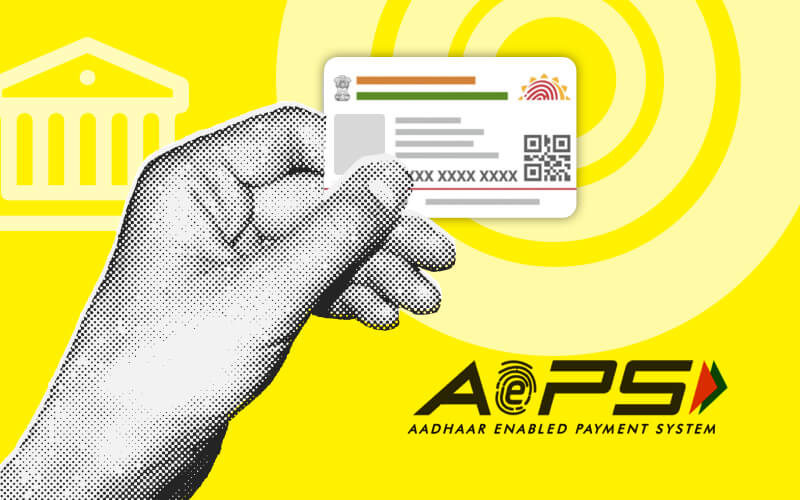The payment service known as the Aadhaar Enabled Payment System (AEPS) enables bank customers to access their Aadhaar-enabled bank account and carry out standard banking operations such as checking their balance, making cash withdrawals, and sending money overseas through a Business Correspondent by using Aadhaar as their identity.
Payments can be made using the unique identification number (UID) in this payment system. All Aadhaar card holders can use AEPS to make payments, transfer money, withdraw money, make a deposit, and perform other bank-related tasks.

What is AEPS?
AePS, or Aadhaar-enabled payment system, is a service developed by the National Payments Corporation of India. It allows users to conduct transactions on a micro-ATM by providing their Aadhaar number and biometric information. Here are the key features of AePS:
- Aadhaar-linked transactions: AePS enables Aadhaar card holders to make transactions through their Aadhaar-linked bank accounts, similar to debit/credit card transactions.
- Biometric authentication: Transactions are completed by submitting the Aadhaar number and biometric details (iris or fingerprint scan) at Points of Sale (PoS) or micro ATMs, using Aadhaar authentication.
- Bank account privacy: Users are not required to share their bank account details during the transaction, enhancing privacy and security.
- Fund transfers: AePS allows users to transfer funds between bank accounts, providing a convenient way to send and receive money.
- Secure transactions: AePS transactions are considered safe and secure as they require biometric authentication, ensuring the identity of the user.
Services Offered by AEPS
- Cash Deposit
- Balance Enquiry
- Cash Withdrawal
- Aadhaar to Aadhaar funds transfer
- Mini statement
- Authentication
- BHIM Aadhaar Pay
- e-KYC
- Best finger detection
- Tokenisation
- Demo Auth
- Aadhaar Seeding Status
Benefits of AePS or Aadhaar Enabled Payment System
- User-friendly: AePS is designed to be user-friendly, making it easy for individuals to understand and use the system for various financial transactions.
- Biometric authentication: The system requires the submission of biometric data (such as fingerprints or iris scans) and the Aadhaar card number for authentication, ensuring secure and reliable transactions.
- Empowering the underprivileged: AePS plays a significant role in empowering the underprivileged sections of society by providing them with access to banking services and enabling digital financial transactions.
- Bank account privacy: Users can complete transactions without having to disclose their bank account details, enhancing privacy and security.
- Convenient Access to Bank Accounts: AePS allows users to conveniently access their bank accounts using Aadhaar authentication, eliminating the need for physical bank visits.
- Enhanced security: The submission of biometric data and Aadhaar number adds an extra layer of security to AePS transactions, making them highly secure and reliable.
- Reach to remote areas: AePS enables the deployment of micro Point of Sale (PoS) machines to remote villages and areas, facilitating easy and accessible transactions for users in underserved regions.
Features of AePS
- Account deduction: The transaction amount is deducted directly from the Aadhaar-linked bank account of the user, ensuring a seamless and straightforward transaction process.
- Basic banking transactions: AePS allows Aadhaar card holders to perform various basic banking transactions, including cash deposits, interbank and intrabank fund transfers, cash withdrawals, balance inquiries, and obtaining mini bank statements. These transactions can be conducted through a banking correspondent.
How to use AePS?
Step 1: You have to go to a micro-ATM or banking correspondent in your area.
Step 2: Then, enter your 12-digit Aadhaar number in the PoS Machine.
Step 3: Provide KYC (Know Your Customer) information to open a new account.
Note: Aadhaar Number should be linked with the bank account.
Step 4: You have to choose the transaction type from the below categories:
- cash deposit
- withdrawal
- mini statement
- fund transfer
- balance enquiry
- eKYC.
Step 5: After that, you need to select the Provide verification through fingerprint/ iris scan
Step 6: Finally, the transaction gets completed, and the banking correspondent will give you a receipt.
FAQs
What is the full form of AePS in banking?
AePS stands for Aadhaar Enabled Payment System. It is an Indian payment system that uses Aadhaar verification to enable online interoperable financial transactions at Micro ATM or Point of Sale (PoS) terminals via any bank’s Business Correspondent (BC).
What is AePS settlement?
AePS settlement refers to the process of interbank transaction routing during routine banking operations. Members of the AePS network maintain a current account or RTGS settlement account with the RBI (Reserve Bank of India) to facilitate the settlement of transactions. Prior to joining the AePS network, members must submit a letter of authorization to the RBI and provide NPCI (National Payments Corporation of India) with an RBI-acknowledged copy.
Practice area's of B K Goyal & Co LLP
Income Tax Return Filing | Income Tax Appeal | Income Tax Notice | GST Registration | GST Return Filing | FSSAI Registration | Company Registration | Company Audit | Company Annual Compliance | Income Tax Audit | Nidhi Company Registration| LLP Registration | Accounting in India | NGO Registration | NGO Audit | ESG | BRSR | Private Security Agency | Udyam Registration | Trademark Registration | Copyright Registration | Patent Registration | Import Export Code | Forensic Accounting and Fraud Detection | Section 8 Company | Foreign Company | 80G and 12A Certificate | FCRA Registration |DGGI Cases | Scrutiny Cases | Income Escapement Cases | Search & Seizure | CIT Appeal | ITAT Appeal | Auditors | Internal Audit | Financial Audit | Process Audit | IEC Code | CA Certification | Income Tax Demand Notice | Psara License | FCRA Online
Most read resources
tnreginet |rajssp | jharsewa | picme | pmkisan | webland | bonafide certificate | rent agreement format | tax audit applicability | 7/12 online maharasthra | kerala psc registration | antyodaya saral portal | appointment letter format | GST Search Taxpayer | caro 2020 | Challan 280 | itr intimation password | internal audit applicability | preliminiary expenses | mAadhar | e shram card | ec tamilnadu | aaple sarkar portal | epf activation | scrap business | brsr | depreciation on computer | west bengal land registration | traces portal | Directorate general of GST Intelligence | form 16 | rtps | patta chitta
